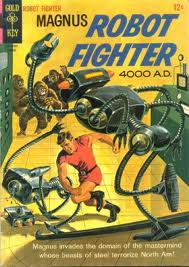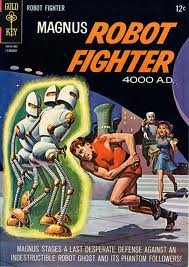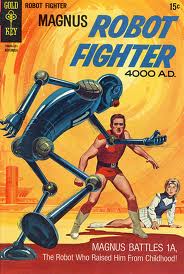Magnus, Robot Fighter
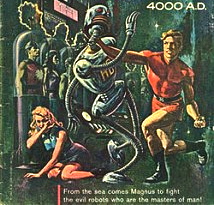
Magnus Robot Fighter – Origin Pt 1- Welcome to North Am Man-Child (with vocals)
Magnus Robot Fighter Origin Story – Magnus is introduced to the tightly controlled human society of North America run by robots.
 Magnus, Robot Fighter 4000 A.D. #1, Gold Key Comics
Magnus, Robot Fighter 4000 A.D. #1, Gold Key Comics
Magnus, Robot Fighter is a fictional comic book superhero created by writer/artist Russ Manning in 1963, based primarily on Tarzan. Magnus first appeared inMagnus Robot Fighter 4000 A.D. #1, published by Gold Key Comics in February 1963. The character was subsequently published by Valiant Comics and Acclaim Comics in the 1990s, and was reintroduced by Dark Horse Comics in August 2010. In every incarnation, Magnus is a human who battles rogue robots in the year 4000, though some aspects of the concept have varied with each publisher.
Premise
By the year 4000, humanity has become dependent on robots. H8, the Pol-Rob chief of the civic sector of North Am, a continent-spanning mega-city, is damaged in a radiation accident. It seeks to promote the human dependency on robots and gradually impose totalitarian rule in the area under its control.
Magnus was raised by a robot known as 1A, a name which implies that he is the very first robot of his type ever manufactured. 1A seems to be self-aware and possess emotions. A firm believer in the Three Laws of Robotics, 1A recognized the threat represented by the dependency of humans on robots in general, and the developments in North Am due to H8 in particular. Therefore, 1A trained Magnus to protect humans against both rogue robots, and humans who used normal robots for evil purposes. Magnus was trained from infancy by 1A in an under-sea domed house, using advanced techniques, to become a skilled martial artist who could break steel with his bare hands. In addition, 1A equipped his charge with a device that would allow him to “hear” robot-to-robot radio communications.
Leeja is Magnus’s girlfriend. Robots that served as police are called “Pol-Robs” (as in police robots) and are painted black and white like city police cars. All robots have identifying numbers painted on their chest and backs. Other robots, such as taxi drivers, could be nothing more than a torso with arms and head attached to a flying automobile.
Both the Gold Key and Valiant versions take place in North Am, a megalopolis that encompasses the entire North American continent. The city consists of several “levels.” The higher levels are populated by wealthier individuals, often regarded as “soft” and complacent. The lowest level, the Goph Level, is populated by a hardier and less educated class known as “gophs.”
By AD 4000, the nation of Japan is home to 50 billion people. The major islands of Japan are covered by a single, contiguous structure known as the Host. Grandmother, a Freewill electronic network, controls virtually every facet of daily life.
Aside from North Am, Earth also features a city on the continent of Antarctica named Antarcto. The city consists of several transparent domes, inside each of which the climate is carefully controlled. Construction of these habitats was fiercely opposed, for fear of ecological damage to the fragile Antarctic system. As well, there is the area known as Himalhina, which apparently includes at least all of India and China.
Characters
- Magnus, Robot Fighter
- 1A, the Freewill robot mentor of Magnus and lover of Grandmother (whom he calls “Kimi”).
- Claiburne, President of North Am
- Leeja Clane, Magnus’s sexy girlfriend and future wife
- Victor Zeramiah Clane, North Am Senator and future President, father of Leeja
- Grandmother, Freewill computer brain of Japan and lover of 1A
- H8, robot police chief, destroyed by the collective mental power of humans he had enslaved
- Torque Magnus, son of Magnus and Leeja Clane
- Mekman, a psychopathic human genius who wants to be a robot
- Mimsey, General of North Am’s military
- Dr. Laszlo Noel, an anti-robot fanatic who later reforms and assists Magnus against Malev-6
- The Outsiders, a group of four adolescents inspired by Magnus
- Rai (Tohru Nakadai), defender of Japan
- Slagger (Tark Mulko), a goph warrior
- T-1, a renegade “think-rob” destroyed by Magnus
- Talpa (“Mole” in Latin), a renegade robot who seeks to enslave the human race.
- Tekla, “female” robot (formerly a serv-rob named W-23), leader of robot nation of Synchron
- York Timbuc, a major, later a colonel, in North Am’s military
- Xyrkol, brilliant but psychopathic alien scientist who seeks to rule North Am
- Predator, on the crossover: “Predator Vs Magnus Robot Fighter”
The original series, titled Magnus, Robot Fighter, 4000 AD, premiered in 1963. It was written and drawn by Russ Manning, and as a nod to its influences, included Isaac Asimov‘s Three Laws of Robotics as a quote in the beginning of the first issue. For the duration of the title’s original run, Magnus battled rogue robots, aliens, space pirates and other threats. He fell in love with Leeja Clane, the daughter of one of North Am’s senators. Leeja developed limited telepathic abilities after training by M’Ree and other humans who had acquired them as a result of their minds being linked together while imprisoned in suspended animation by H8. The series was popular in the 1960s. As the ’70s approached, sales began to decline. The last issue (#46) was published in January 1977. However, Manning only completed 21 issues; the rest were reprints of previous issues or new stories by others (#23-28).
The original concept is a deliberate inversion or update of the Tarzan mythos, the syndicated comic strip which Russ Manning had previously illustrated. Where Tarzan was a human raised as a noble savage feral child by African great apes who saw the world through his naturalistic upbringing and opposition to the rules and limits of civilization, Magnus was a human raised by a benevolent robot named 1A, who saw mankind becoming ever more decadent and complacent human civilization doomed by its ever-increasing dependence on robots. In one case, the hero is a throwback to a hardier and more naturalistic time. In the other, he is a creation of science sent to carry the message to the rest of humanity that Man must control his own destiny and carve out his own path, rather than become little more than an overfed herd of cattle tended by robots. In both incarnations of Magnus, Robot Fighter, he lives and operates according to his own set of rules and because of this, is considered an outsider and something of a threat to the established order of things.
In the early ’80’s, a new Magnus backup series ran in the new Doctor Solar title in issues #29–31. This was supposed to lead to a new Magnus title, but GK stopped publication soon afterwards. Supposedly, there was work completed for two new Magnus issues (what would have been Magnus #47, 48), but have never been published.
Valiant
In 1991, Jim Shooter obtained rights to three Gold Key characters: Doctor Solar, Man of the Atom; Turok, Son of Stone; andMagnus, Robot Fighter. He intended to use those characters to launch his new comic book line, Valiant Comics. Several months later, the company launched Magnus, Robot Fighter.
The series began where the original one left off. The artists took great care to replicate the setting and trappings of the original stories. But as the new series progressed, it began to deviate from the original concept. The term “Freewills” appeared in the Valiant run, introducing the concept that the rogue robots seen previously were not simply the product of random malfunctions, but were the result of a common phenomenon which allowed robots to become sentient. While some of them were malevolent, others merely wanted to be free. It was also learned that 1A was also a freewill. With Magnus’s help, a colony of benevolent Freewills was established called the “Steel Nation.” At the same time, Magnus became disgusted with North Am’s elite. He journeyed to the lower levels of North Am and befriended a group of social outcasts known as Gophs.
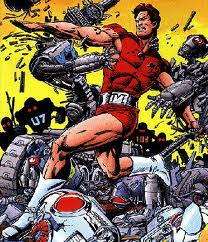 As the series progressed, it was used to introduce other heroes to the Valiant Universe. In issue #5, a Japanese hero known as Rai began appearing in Magnus’s title, and would eventually move on into his own series. In the sixth issue, the future version of Solar made his debut. The issue also introduced the spider aliens, who became a recurring threat throughout the Valiant Universe. In the 12th issue, modern readers were reintroduced to Turok, Son of Stone.
As the series progressed, it was used to introduce other heroes to the Valiant Universe. In issue #5, a Japanese hero known as Rai began appearing in Magnus’s title, and would eventually move on into his own series. In the sixth issue, the future version of Solar made his debut. The issue also introduced the spider aliens, who became a recurring threat throughout the Valiant Universe. In the 12th issue, modern readers were reintroduced to Turok, Son of Stone.

